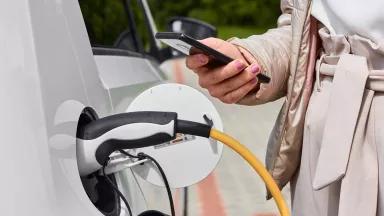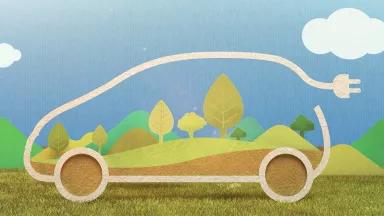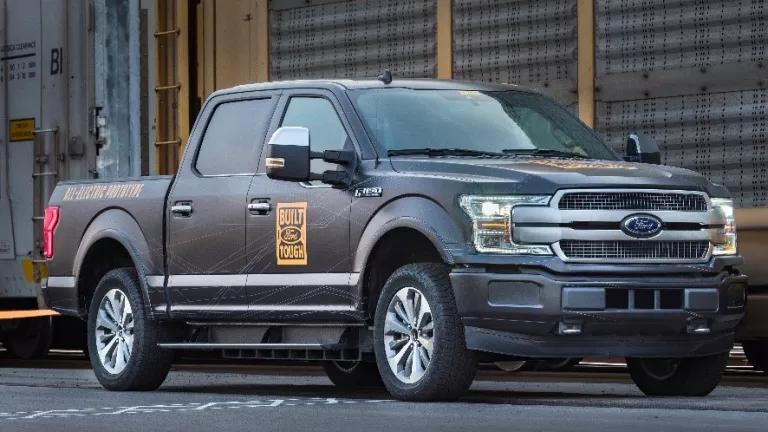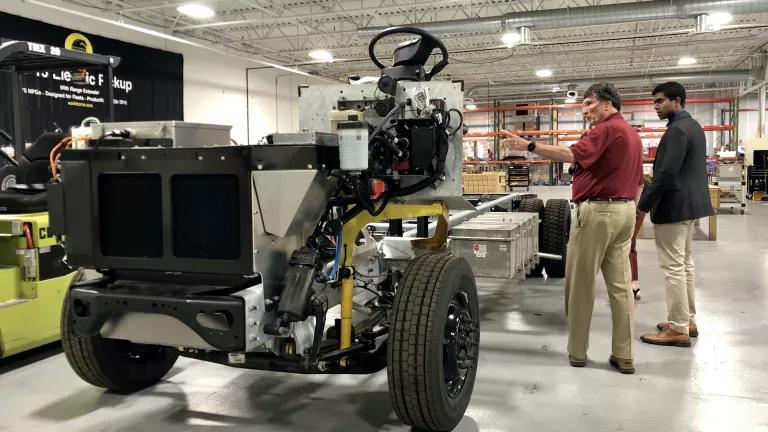Reflections on a Road Trip without Gasoline
We’re walking you through our most important discoveries from our electric road trip throughout the Midwest: the lessons learned by sitting behind the wheel and by listening to all the transportation stakeholders who told us their stories.
This is the thirteenth and final blog in a series about our Midwest electric vehicle adventure.
Earlier this summer, we went on a road trip through the Midwest in an electric vehicle (EV) to meet with and learn from a variety of stakeholders who represent the diverse faces and facets of the changing transportation sector, while also showing off the increasingly long distances that fully electric vehicles like our Chevy Bolt can drive on a single charge.
To conclude our blog series, we’re walking you through our most important discoveries from this road trip: the lessons learned by sitting behind the wheel and by listening to all the transportation stakeholders who told us their stories.

Jessica Russo
Our Electric Road Trip by the Numbers
To recap our electric road trip for you, we’re going to break it down into numbers. We drove 1,611 miles in 1 electric car with zero stops at the gas pump. We visited 9 cities in 5 states for conversations with 40 electric transportation stakeholders over 10 days. Our EV had a 60 kilowatt-hour battery that gave us a 220-mile range on average. This range was more than sufficient: we never came close to an empty battery! Even on our longest drive, we still had 50 miles to spare.
We did 7 nights of destination charging, which is the word the EV community uses for the experience of parking, plugging in, and leaving your electric car connected for the duration of your stop. This destination charging cost us $31 total over the course of the trip. To charge up our battery on some of our longer drives between cities, we did 7 stops at fast charging stations. We spent $72 and about 5 hours total at these fast charging stations. While our car’s battery was filling up, we used the time to eat lunch at nearby restaurants, to get coffee to re-energize ourselves, or to get road trip snacks and souvenirs at businesses within walking distance.
All in all, we spent $103 total charging our EV, almost $60 less than it would have cost to use gas as our fuel on the same trip. Using last month’s average gas prices across the states we drove through and imagining that we drove a 2017 Chevy Sonic—a car of a comparable size that gets 28 miles per gallon—instead of our 2017 Bolt, we would have spent approximately $160 on gas to complete the same itinerary.
Driving electric saved us money, we found convenient, fun, and easy ways to pass the time while our car was charging, and we loved the smooth, silent, and speedy EV driving experience. Our first takeaway: EVs are just more fun to drive. Our second takeaway: they’re already great for road trips.
Range Anxiety, Meet the Learning Curve
Our charging costs went down over time, because we got smarter about it as we did it more often. While there are definitely some tricks for saving money at the pump, there’s no equivalent learning curve in a gas car. None of us had driven electric for any meaningful amount of time before this adventure—we learned a lot about how EVs work and how to charge them—so our learning curve can be measured by comparing our behavior on the first day to the last day of the trip.
When we picked up our EV rental in Detroit, the Bolt’s battery was 80 percent full and we needed to drive a little less than 200 miles to Columbus, Ohio by the end of the day. Our Bolt is one of the longer range EVs available on the market, with a maximum range of 238 miles. For reasons that are now both mystifying and laughable—and which can probably be traced back to range anxiety—we decided we needed to stop at a Level 3 (fast) charger almost immediately to completely fill up our car’s battery, even though we knew there was another fast charger that provided free charging at a dealership about halfway between the two cities and we knew our hotel in Columbus had a charger in its parking lot that would allow us to plug in and fill up our battery overnight. We ended up charging at all three stations. This kind of behavior is the EV equivalent of never letting your phone battery drop below 70 percent because a friend is going to call you later.
That day’s charging experiences were lovely, nevertheless. During our first ever charging stop, pictured above, a father and his two children were so intrigued by our setup that they got out of their minivan and came over to talk to us about EVs. “It’s a beautiful thing, not to have a tailpipe,” the father told us, admiring our plugged-in car while his sons explored the interior and its screens. “This is the future.”
On our second fast charging stop, we took a stroll through the town of Findlay, Ohio and found a nice brewpub to eat a late lunch. These charging stops still don’t feel like a waste of time but, looking back, it is clear that it was not the best use of money and energy.
In contrast, our charging behavior was more intentional and financially sensible after we had spent just a few days with our EV. Pulling into our hotel in downtown Detroit on our last night on the road, we looked at our dashboard and saw we had 60 percent, or about 125 miles, left on our battery. We quickly decided it wasn’t worth the money, kilowatt hours, or time to drive the few extra blocks to the parking lot full of Level 2 chargers nearby to charge overnight. We knew we had to drive to several different destinations around the Detroit metro area the next day, but we also knew that our Bolt would be able to make it.
By the end of the trip, we were much more relaxed electric drivers with an intuitive sense of what the car needed to get us where we wanted to go. Not only does this relationship with the EV battery feel better—at least to us—but it saves EV drivers money on charging and conserves energy too.
Our third takeaway: range anxiety is easily and quickly overcome by following the natural learning curve that comes with spending time driving an EV.
EVs Are a Midwest Tradition, and Part of Its Future
After visiting manufacturing and R&D facilities and speaking to EV drivers and enthusiasts across multiple states, we saw firsthand how much electric cars are part of the Midwest’s economy, culture, and history.
In fact, the country’s first electric car, unveiled in 1890, was built by an Iowan. A few decades later, outside Detroit, Henry Ford was busy working on a more advanced and affordable EV. This spring, the Ford Motor Company returned to its founder’s vision and invested $500 million in Rivian, an electric pickup and SUV manufacturer with its headquarters in Plymouth, Michigan. Ford’s investment in Rivian complements another step the company has taken toward (re-)electrifying transportation: they’re working on a fully battery-electric version of their best-selling pickup, the F-150, too.
As automakers like Rivian and Ford diversify the kinds of EVs available to consumers, even more drivers will become a part of the electric car community. We hope that would include Midwesterners like Mike Hill, a senior engineer at the St. Louis battery testing company Bitrode, who told us he would go electric so long as he could keep driving a pickup that could tow his boat to the lake on weekends. Considering that Ford’s electric F-150 prototype can tow a million-pound train, we’re thinking that electric pickups will have enough power to pull Midwesterners’ boats and haul any other cargo just fine.
Our fourth takeaway: EVs are both technologically pioneering and part of the Midwest’s history.
The Midwest’s EV Economy Is Already Big, and Growing
Rivian will begin production of its electric pickups and SUVs next year at the auto manufacturing plant in Normal, IL that Mitsubishi closed in 2015. By purchasing and retooling that facility, Rivian is spurring economic activity in this region full of automotive history and providing opportunities for some former Mitsubishi workers to apply all their automotive expertise to the manufacturing of EVs.
On our trip, we saw that the EV economy supports jobs across a variety of industries and sectors. In addition to manufacturing, a fully electrified transportation sector relies on workers who can install and maintain charging stations, electricians who can upgrade wiring in homes and workplaces to support EV charging. It relies on fleet managers and administrators at universities (like Western Michigan University and University of Illinois Urbana-Champaign) and in cities (like Indianapolis and Chicago) who can oversee the logistics of the transition from gas-powered work vans and buses to electric ones, and battery testing and safety engineers (like those at Bitrode in St. Louis), among others.
The EV economy already supports 24,5100 jobs across the Midwest—and that’s only counting jobs related to fully battery electric vehicles, like our Bolt. If we expand the category to include plug-in hybrid and hybrid electric vehicles, the electrifying transportation sector supports 83,650 jobs in the Midwest.
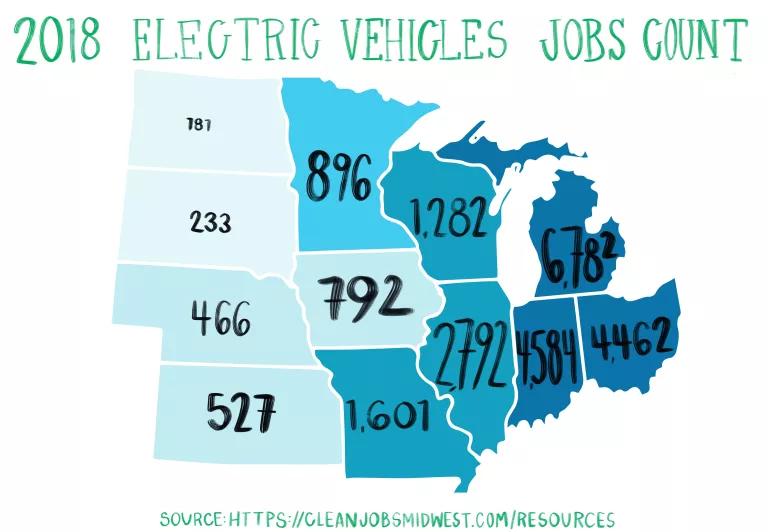
Illustration by Jessica Russo
Reducing barriers to EV adoption with state- and city-level policies that work would create positive ripple effects throughout the Midwest—not just by improving air quality and reducing carbon emissions, but also by creating an economic environment that would foster job growth in the multifold sectors integral to transportation electrification.
Our fifth takeaway: The Midwest’s tradition of automotive innovation means that EVs fit right into its economy and have the potential to grow it.
Countless Reasons to Drive Electric
During our road trip, we tried to ask everyone we met with what kind of car they drove and why. It became immediately apparent that there is no one reason why a Midwesterner switches from a gas-powered vehicle to an electric one. On just one day, we heard from one Ohioan who decided to ditch her personal vehicle entirely for convenience and to save money, while others wanted to reduce their energy costs and carbon footprints—and another was concerned with the intersection of foreign policy and fossil fuel dependence. In other words, the motivations driving electric vehicle adoption are as diverse as Midwest EV drivers themselves.
Nevertheless, a few trends emerged over the course of all our conversations with electric transportation stakeholders.
- Fun: Every EV driver we spoke with highlighted the sheer pleasure of the smooth, silent, and speedy ride that only an EV can provide. As a Motor City valet driver commented while getting out of our car, “It’s so zippy! It’s like riding on air.” After hearing comments like this every day of our road trip, we’re confident that simply making EVs available for people to drive—either through zero-emission vehicle policies or through public-private partnerships like Smart Columbus—will go a long way toward increasing electric vehicle adoption.
- Affordability: EVs are already the most budget sensible option for many, despite common stereotypes to the contrary. An ever increasing variety of EV models are available at different price points nowadays, and all of them provide significant and meaningful savings on fuel and maintenance.
- Cool technology: After eating some deep dish pizza in Chicago, we returned to our parked EV—only to find it was the subject of a pedestrian’s impromptu photo shoot. They thought our Bolt was so cool that they invited us to sushi. By this point, we had already engaged with so many intrigued and curious passersby that this photo shoot and dinner invitation did not register as unordinary. Automakers and decision-makers can do more to build on this widespread curiosity about EV technology to increase the rates of clean car adoption.
- Human health in neighborhoods: Reducing tailpipe emissions has tremendous consequences for human and ecosystem health both locally and globally. On the local level, the ground-level ozone precursors that contribute to smog and the particulate matter that contributes to soot both come out of gas cars’ tailpipes and disproportionately impact the health of our most vulnerable neighbors, including children, the elderly, and those with pre-existing respiratory diseases like asthma. For many among us, a bad air day can mean a hospitalization or even the loss of a loved one. As the Michigan public librarian and EV driver Ben Brown put it, “Breathing this stuff is hurting us.” And because of our society’s systemic racism and classism, we don’t all breathe the same stuff. Low-income, Black, and brown communities are typically burdened with more polluted air (and water). City policies have the power to at least begin to undo that injustice. In Chicago, for example, officials at the Department of Transportation are implementing an electric bus pilot for the #66 line, which they chose because it runs through several pollution-burdened communities.
- Human health and climate change: On the global level, transportation is now the highest emitting sector of greenhouse gases nationally and it emits the most carbon dioxide in many states as well. Replacing gas-powered and polluting cars with tailpipe-free electric vehicles that plug into an increasingly carbon-free grid is the simplest way to reduce emissions of planet-warming and asthma-inducing gases.
- Foreign policy: We also heard from many Midwest drivers who were concerned about the country’s fossil fuel dependence and the way that influences foreign policy decisions that can have life-and-death consequences for those who serve in the Armed Forces. “We’re addicted to fossil fuels,” several members of the Kalamazoo Electric Vehicle Association agreed. “Too many people have died in the sand over a barrel of oil,” said Don Wires, a Vietnam veteran and senior engineer at the electric truck company Workhorse. “There are alternatives.”
Thank u, Midwest
Our last takeaway? The Midwest is a fantastic place for an electric road trip. We were consistently impressed with and grateful for the extraordinary generosity and openness of everyone we met with, from individual EV drivers and community groups, to researchers at universities, and city policymakers. Our road trip would have been a far different and less enjoyable and memorable experience were it not for their willingness to share their time, stories, and expertise.
We hope this blog series has provided you with the motivation, tools, and inspiration to go plan your own electric road trip. We know we sure can’t wait to go on our next one.
To see more from all these wonderful Midwesterners, visit @electricroadtrip2019 on Instagram. In addition to our reflections from the trip, we’ll leave you with a farm-fresh and mouth-watering grape pie.

We went on a Midwest electric vehicle road trip to talk about transportation policy, highlight the already booming benefits of electric vehicles to local economies, and shatter stereotypes about what it means to be an electric vehicle driver. We’ve been blogging about our findings, including tips for other aspiring roadtrippers and policy suggestions for further progress.
Other blogs related to our electric adventure include:
Driving (on) Clean Energy: Touring the Midwest in an EV
State of the States: EVs and EV Policy in the Midwest
Road Trip Report: How Ohioans Buy EVs (It Should Be Easier)
Avoiding Range Anxiety with an EV Road Trip Checklist
Road Trip Report: Midwest Cities Move Multimodal
Midwest Electric Vehicles in 5 Maps
Road Trip Report: On Charging Champions and Public Policy
This Is What the EV Revolution Looks Like

